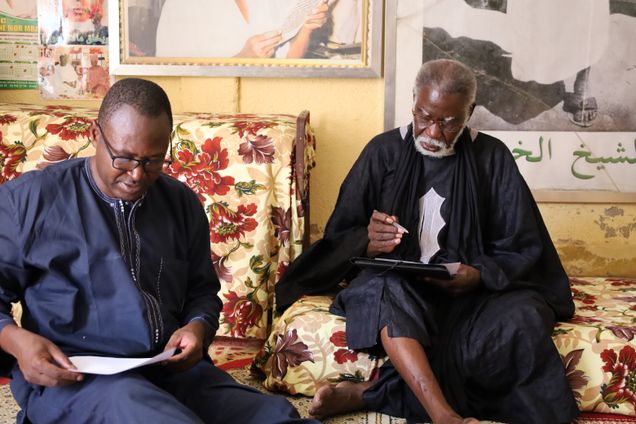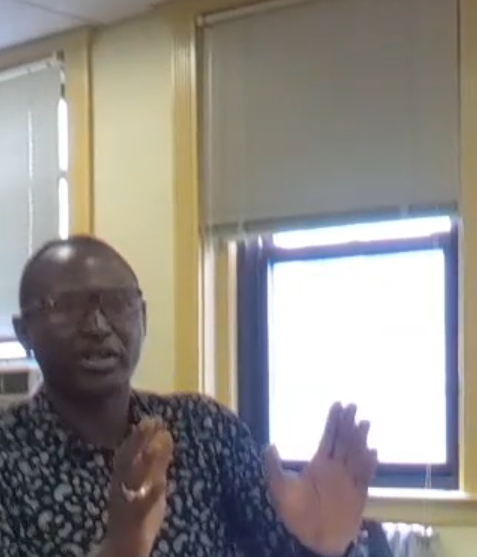Collecting, Digitizing, Transcribing, and Translating Wolof and Mandinka Ajami Manuscripts
By Ablaye Diakite
My tasks for the NEH Ajami project involved several different aspects of the project, such as performing fieldwork in the communities of West Africa to collect and digitize Ajami manuscripts, interviewing manuscript owners and collectors and making audio and video recordings, but also transcribing Ajami manuscripts into Latin script and translating the manuscripts into English and French. I worked with both Mandinka and Wolof language teams. I am a native speaker of both of these languages, and have worked with various research projects focusing on Senegambian languages for over a decade.
This linguistic experience and familiarity with local communities were of immense help for me in all aspects of my work with the NEH Ajami project. Both the fieldwork with local manuscripts owners and authors, and the transcription and translation processes involved challenges, but also offered opportunities for innovations and improvement. All these aspects of my work highlighted the importance of collaborating with local specialists and community-based partners.
For example, when transcribing the Ajami manuscripts into Latin script to prepare them for translation, it could be noticed that the writing was not clear at times. For most manuscripts, the project made audio recordings of local African Ajami specialists reading or chanting the texts and delivering live commentary, to clarify the areas that were less understood. That practice was very helpful, but on several occasions, we had to send the text back to the readers and local Ajami experts to further clarify the meaning of certain phrases. We found that it was very important to locate the texts in the lived experience of the communities, which provided contextual knowledge and relevant historical and cultural information for a proper interpretation of the manuscripts.
When identifying manuscripts for digitization, we worked closely with local communities. Our facilitators were often esteemed elders who were knowledgeable about local Ajami texts and their authors and collectors, and who were respected in their communities. The preparatory work of information gathering and identifying manuscripts and their owners started already before the visit of our field team. When working with local households and informants, we were careful to respect people’s time, as well as local customs and cultural conventions, such as greeting and other hospitality protocols. As we often had to spend considerable amounts of time in people’s houses, setting up the recording and lighting equipment and taking images, it was important to try our best to not take advantage of people’s hospitality. Many of our hosts were farmers, and keeping them away from their fields for extended periods of time could affect their livelihoods. However, people were generally eager to contribute their knowledge and share their Ajami manuscripts and texts.

They were motivated by the goals of preserving that knowledge and making it more broadly available, as well as spreading the knowledge about Ajami literacy and its important role in African communities. We were always careful to explain the purpose and process of the fieldwork to everyone involved. At the end of the digitization process, we also tried to make sure that all of the manuscript owners and authors received digital copies of their manuscripts (they also retained the hard copies). All these steps were essential for establishing and maintaining trustworthy relations with our local partners.
The remoteness of the villages, unstable electricity supply, and poor internet availability created particular challenges for the fieldwork. We often encountered poor lighting conditions that hampered manuscript digitization and delayed our work. We had to plan our work according to the position of the sun and frequently take the images outside, in the courtyards of local households. Bringing along additional equipment such as light ring also helped. It was important to bring backup batteries and make sure the camera battery was regularly charged. It was also important to regularly save and back up all the images, using different modalities – our project’s google drive, as well as external hard drives and other available options. Due to poor internet connection in many areas, saving data and images could be very time consuming, and access to internet often came with high data costs.

Despite our best efforts, mistakes did occur. In one instance, we spent a whole day digitizing around 1,000 pages, but then it turned out that the technician had made a mistake when setting up the equipment, and we had to return another day.
Throughout the fieldwork process, we learned that improving a strategy is a process and learning experience. We learned from our mistakes and were able to come up with innovative solutions and achieve better results next time. We also learned that the success of the project depends on the coordination of a multitude of activities and diverse skill sets of our project members as well as our local partners – it truly is a matter of teamwork.
Ablaye Diakite, a native speaker of Mandinka and Wolof, is a Senegalese linguist who has worked on Senegambian languages for over a decade. He has served as a research assistant and local team leader for several projects of Boston University’s African Studies Center, and coordinated BU’s Foreign Language and Areas Studies summer intensive programs in Senegal. He also worked as a Senegalese team leader for the digital preservation of Wolof and Mandinka Ajami manuscripts led by Professor Fallou Ngom.